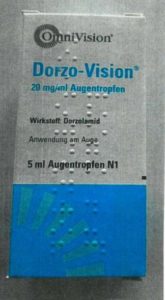Combining trademarks with further elements or sub-brands is quite popular. A recent decision of the German Federal Supreme reminds once more what to watch out for if you do not want to lose your trademark rights (decision of 11 May 2017 in Case I ZB 6/16).
The owner of the German word mark registration for “Dorzo” had opposed a German trademark registration for “Dorzo plus T Stada”. The opposition was successful before the German Patent and Trademark Office, but in the appeal proceedings before the German Federal Patent Court this decision was lifted. During the proceedings before the Federal Patent Court, the earlier mark “Dorzo” had become subject to the use requirement. As allowed by German trademark law, the owner of the attacked mark requested proof of genuine use of the opposing German trademark “Dorzo” for the five years preceding the decision.
The opponent produced evidence according to which a licensee had used the signs “Dorzo-Vision®”, “DorzoComp-Vision®” and “DorzoComp-Vision® sine” for medical eye drops as depicted below:
According to the Federal Patent Court the use of these composite signs was not sufficient to prove genuine use of the mark “Dorzo”, as the additions altered the distinctive character of the trademark “Dorzo”. The Federal Patent Court consequently rejected the opposition due to lack of proof of use of the opposing mark “Dorzo”.
The opponent appealed this decision to the Federal Supreme Court, but could not convince the Court that the additions would not alter the distinctive character of the trademark “Dorzo”:
- According to the Court the joining of “Dorzo” with the additional elements through the hyphen and the uniform coloring of the complete composite signs on its own would not necessarily make “Dorzo” an integral part of these composite signs. However, the fact that the ® was not located behind “Dorzo”, but at the end of “Dorzo-Vision®” resp. “DorzoComp-Vision®” and the conceptual correlation of all elements allowed the finding that “Dorzo” was rather an integral part of Dorzo-Vision®” and “DorzoComp-Vision”.
- Also the fact that “Dorzo” possibly maintained its independent distinctive character within the signs “Dorzo-Vision®” resp. “DorzoComp-Vision®” was nothing to be taken into account for the purpose of assessing its genuine use. For evaluating whether the distinctive character was altered through additional elements it is irrelevant whether the original trademark maintained its independent distinctive character.
- The opponent also failed to convince the Court that the public would recognize “Dorzo” as separate trademark because it commonly used a “Vision”-family of marks. The evidence provided, namely information on the product names used and the corresponding turnover, did according to the Court not prove that a “Vision”-family of marks was indeed known by the relevant public. In addition, this would also require the relevant public to know more than one product line of the opponent.
The Court denied to refer the case to the European Court of Justice (CJEU) as the decision on this case was in line with the CJEU’s jurisdiction on genuine use of trademarks as part of composite signs.
Whether the Supreme Court’s perception of the CJEU’s understanding of what „alteration of distinctive character“ really means is correct, is questionable with a view to the recent CJEU judgment in the CACTUS matter (C-501/15 P), on which there will be a separate blog entry – so watch this space!
In order to be on the safe side when using trademarks together with additional elements it should therefore be strictly avoided to join the elements as happened in this case. Attention should also be given to the right position of the ® for indicating the trademark registration.
_____________________________
To make sure you do not miss out on regular updates from the Kluwer Trademark Blog, please subscribe here.




